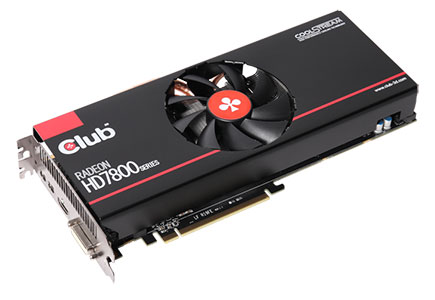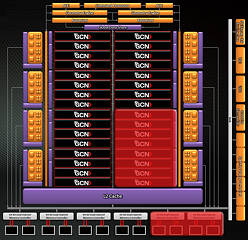 31
31
Club 3D HD 7870 jokerCard Tahiti LE 2 GB Review
Packaging & Contents »Introduction

Towards late-November, AMD made a halfhearted attempt at launching a new performance-segment GPU that strikes a price-point right in between the Radeon HD 7870 GHz Edition and the Radeon HD 7950, and that's putting it mildly. There was confusion over specifications and name until the very last minute. AMD finally decided not to make a reference-design card which left the decision to its partners, most of whom decided against releasing the SKU so as not to disturb their swelling HD 7870 GHz Edition and HD 7950 inventories. To make matters worse, AMD chose the brilliant SKU name of "Radeon HD 7870."

Amongst the only AMD board partners that opted to make cards based on this chip, which has been codenamed "Tahiti LE," are those that rely on contract manufacturer TUL Corporation. These board partners include Club3D, PowerColor, and VTX3D, and the latter two are even owned by TUL. Today, we have with us Club3D's contraption called the HD 7870 jokerCard;It is a part of Club3D's Poker Series.
AMD's new GPU is called "Tahiti LE" even though it's a part of the Radeon HD 7800 series, because it is derived from the same 3.5 billion-transistor "Tahiti" silicon that goes into making all Radeon HD 7900 series products and not the "Pitcairn" silicon that goes into making the HD 7870 GHz Edition and HD 7850. The new SKU drops the "GHz Edition" moniker by featuring lower clock speeds than the HD 7870 GHz Edition, but it makes up for that with more pixel-crunching muscle.
The HD 7870 "Tahiti LE" is carved out of the Tahiti silicon by disabling a fourth of its Graphics CoreNext clusters, which results in a stream processor count of 1,536, a texture memory unit (TMU) count of 96, and a raster operations processor (ROP) count of 32. The memory bus width has been reduced by a third; now, it is 256-bit wide and holds 2 GB of memory. The new chip features PowerTune with Boost: a dynamic core overclocking equivalent to NVIDIA's GPU Boost. The card ships with a GPU clock speed of 925 MHz, PowerTune boost clock of 975 MHz, and 6.00 GHz memory for a memory bandwidth of 192 GB/s.
| Radeon HD 6950 | GeForce GTX 570 | Radeon HD 6970 | Radeon HD 7850 | GeForce GTX 660 | Radeon HD 7870 | Club3D HD 7870 jokerCard | GeForce GTX 580 | GeForce GTX 660 Ti | Radeon HD 7950 | GeForce GTX 670 | Radeon HD 7970 | |
|---|---|---|---|---|---|---|---|---|---|---|---|---|
| Shader Units | 1408 | 480 | 1536 | 1024 | 960 | 1280 | 1536 | 512 | 1344 | 1792 | 1344 | 2048 |
| ROPs | 32 | 40 | 32 | 32 | 24 | 32 | 32 | 48 | 24 | 32 | 32 | 32 |
| Graphics Processor | Cayman | GF110 | Cayman | Pitcairn | GK106 | Pitcairn | Tahiti | GF110 | GK104 | Tahiti | GK104 | Tahiti |
| Transistors | 2640M | 3000M | 2640M | 2800M | 2540M | 2800M | 4310M | 3000M | 3500M | 4310M | 3500M | 4310M |
| Memory Size | 2048 MB | 1280 MB | 2048 MB | 2048 MB | 2048 MB | 2048 MB | 2048 MB | 1536 MB | 2048 MB | 3072 MB | 2048 MB | 3072 MB |
| Memory Bus Width | 256 bit | 320 bit | 256 bit | 256 bit | 192 bit | 256 bit | 256 bit | 384 bit | 192 bit | 384 bit | 256 bit | 384 bit |
| Core Clock | 800 MHz | 732 MHz | 880 MHz | 860 MHz | 980 MHz+ | 1000 MHz | 975 MHz | 772 MHz | 915 MHz+ | 800 MHz | 915 MHz+ | 925 MHz |
| Memory Clock | 1250 MHz | 950 MHz | 1375 MHz | 1200 MHz | 1502 MHz | 1200 MHz | 1500 MHz | 1002 MHz | 1502 MHz | 1250 MHz | 1502 MHz | 1375 MHz |
| Price | $170 | $250 | $380 | $185 | $230 | $245 | $270 | $430 | $280 | $310 | $380 | $390 |
Apr 4th, 2025 01:21 EDT
change timezone
Latest GPU Drivers
New Forum Posts
- New posts added to last post (3)
- GPU-Z question on specific shared mem field *values* (1)
- TPU's F@H Team (20418)
- What's your latest tech purchase? (23465)
- Windows 11 General Discussion (5923)
- Last game you purchased? (747)
- Show us your backside! (9)
- Extigy2 AE - Sound Blaster SBX Pro Studio effects for most sound devices (10)
- 4x16gb how are these? (24)
- Is the futureproof gaming solution a four drive system? (56)
Popular Reviews
- DDR5 CUDIMM Explained & Benched - The New Memory Standard
- PowerColor Radeon RX 9070 Hellhound Review
- Sapphire Radeon RX 9070 XT Pulse Review
- Corsair RM750x Shift 750 W Review
- Pwnage Trinity CF Review
- Sapphire Radeon RX 9070 XT Nitro+ Review - Beating NVIDIA
- Upcoming Hardware Launches 2025 (Updated Apr 2025)
- SilverStone Lucid 04 Review
- Palit GeForce RTX 5070 GamingPro OC Review
- AMD Ryzen 7 9800X3D Review - The Best Gaming Processor
Controversial News Posts
- MSI Doesn't Plan Radeon RX 9000 Series GPUs, Skips AMD RDNA 4 Generation Entirely (146)
- Microsoft Introduces Copilot for Gaming (124)
- AMD Radeon RX 9070 XT Reportedly Outperforms RTX 5080 Through Undervolting (119)
- NVIDIA Reportedly Prepares GeForce RTX 5060 and RTX 5060 Ti Unveil Tomorrow (115)
- Over 200,000 Sold Radeon RX 9070 and RX 9070 XT GPUs? AMD Says No Number was Given (100)
- NVIDIA GeForce RTX 5050, RTX 5060, and RTX 5060 Ti Specifications Leak (96)
- Nintendo Switch 2 Launches June 5 at $449.99 with New Hardware and Games (90)
- Retailers Anticipate Increased Radeon RX 9070 Series Prices, After Initial Shipments of "MSRP" Models (90)
